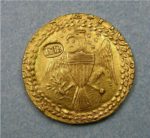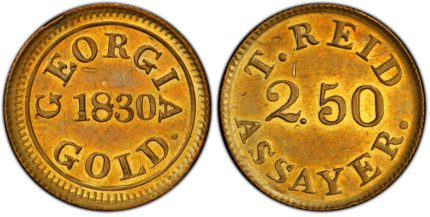A coin struck in 1830 during the Georgia Gold Rush has sold at auction for a record price of $480,000. The previous record set in 2013 was $329,000. The gold coin about the size of a modern nickel valued at $2.50 (a quarter Eagle) has been in private collections in the Midwest and West Coast since the 1970s. The new buyer is a private collector who wishes to remain anonymous except for one detail: he or she is from Georgia, so the coin is going back to its home state for the first time in at least 50 years.
The Georgia Gold Rush was sparked in 1828 when gold was discovered in Dahlonega, north Georgia, then Cherokee territory. Mining operations cropped up everywhere, illegal incursions into Cherokee land. The Indian Removal Act legislating the forced relocation of all Native American nations east of the Mississippi to Oklahoma was passed in 1830, a direct result of the gold strike and the flood of white prospectors.
The area was short of currency. It operated largely on a barter economy, with banks keeping the limited number of coins imported to the area out of circulation so they could use them to pay import duties. Getting good value from gold dust and nuggets by bartering them was challenging, to say the least. Impurities in the raw material made weighing and assay inaccurate.
When the first gold rush in the United States, the Carolina Gold Rush of the early 1800s, had taken off, the US Mint set up a federal branch in Charlotte to process the raw gold into gold coins, but the federal response to the success of the Georgia mines was slow. Miners had to transport unrefined gold to the only national mint in Philadelphia for processing, a long, dangerous journey, and pay a steep price in express shipment and insurance charges.
Enter Templeton Reid, a silversmith, machinist, inventor, clockmaker and gunsmith who lived and worked in Milledgeville, then the capital of the state of Georgia. He had the idea of starting up a mint to convert the raw gold into coins of $2.5, $5 and $10 dollars, matching the denominations of  the US mint’s gold Eagles. To that end, he built an apparatus that struck coins from gold dust, boldly stamped “GEORGIA 1830 GOLD” on the obverse, and the minter’s name “T. REID,” the value and “ASSAYER” on the reverse. This was the first private mint since Ephraim Brasher of New York’s foray into doubloons in 1787.
the US mint’s gold Eagles. To that end, he built an apparatus that struck coins from gold dust, boldly stamped “GEORGIA 1830 GOLD” on the obverse, and the minter’s name “T. REID,” the value and “ASSAYER” on the reverse. This was the first private mint since Ephraim Brasher of New York’s foray into doubloons in 1787.
Reid’s mint opened in Milledgeville in July 1830, moving shortly thereafter to Gainesville, about 10 miles from the epicenter of the gold mining district. His coins quickly went into circulation and things were going well for minter and miner alike until August 16th, 1830, when a letter to the Georgia Courier by an anonymous writer calling himself “No Assayer” claimed that he had had one of Reid’s $10 coins assayed at the federal mint and found that its real value was $9.38. The $2.50 and $5 coins were similarly short. He accused Reid of making what I guess he thought was a usurious profit of 7% which, even if true, would have been on the very low end of the costs incurred by miners to send their gold to the Philly mint, while offering enormous advantages in speed and convenience of the conversion.
Reid wrote an incensed rebuttal to these accusations which was published on September 11th, 1830. No Assayer came back at him on September 20th, this time upping the ante to accuse Reid of violating the Constitution of the United States and of offensively suggesting that “the Mint of the United States, managed by men of strictest integrity, and chosen for their knowledge in the science of mineralogy, and bound by the oaths and bond for their faithful discharge of the duties connected with the department of government, is beyond a doubt wrong.”
The anonymous writer never offered proof of his putative mint assay and the newspaper just printed the back-and-forth without investigation or comment. In truth, Reid put more gold in his coins than the federal mints put in theirs and to ensure the most possible purity, he never added alloys. Any purity issues were inherent to the raw material and the result of limited technology Reid had access to in the assay of the miners’ gold.
Still, the damage was done. The public fight had tarnished Reid’s reputation and banks and shops began to refuse his coin. Three months after it opened, the Reid mint folded. It would eight years before the federal government opened a branch of the mint in Dahlonega. Reid went back to his previous business endeavors, building cotton gins, manufacturing and repairing gin equipment.
Out of thousands minted in those few brief months, today there are about 25 or so surviving $2.50 Reid coins, and fewer than 10 of the $5 and $10 ones. The one that just set the record is the only example of its issue in mint condition and is indeed the finest graded Templeton Reid coin of any denomination.
